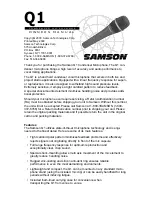
40
UHF System Configuration
Booster power supply
The booster power supply voltage, drive voltage, and supported gain will differ, depending on the
equipment. Refer to the table below for details.
Category
Model
name
Supply voltage
for AN series UHF
antennas
Voltage selection
method
Drive voltage
Voltage
selection
method
Support gain/attenuator
Gain/attenuator
Voltage selection
method
Receiver/Divider
DWR-R01D
0 V/9 V/12 V
Menu*1
—
0 dB/–5 dB/–10 dB*
5
Menu
DWR-S01D
0 V
—
0 dB/–5 dB/–10 dB
Menu
WD-850
0 V/9 V/12 V
Front-panel switch*
2
*
6
0 dB
—
Antenna/Booster
AN-01
—
9 V/12 V*
3
Switch
0 dB/10 dB/18 dB/Auto*
6
Trim switch
AN-820A
9 V/12 V*
3
*
4
None (Auto)
Auto*
6
Auto only
WB-850
9 V – 12 V
—
–10 dB/0 dB/+10 dB
Selector switch
*1 Separate power supply voltage setting for antenna A/antenna B not supported.
*2 Separate power supply voltage setting for antenna A/antenna B supported.
*3 0 V is not supported. Use as a passive antenna is not possible. Power supply must be provided.
*4 Supplying 12 V to legacy models may result in fatal damage. When selecting 12 V, be sure to obtain a new AN-820A. When
supplying 12 V to an owned AN-820A, make sure that a label that includes frequency information is affixed next to the LED
indicators at the bottom of the unit.
*5 The antenna output level reflects the attenuator setting. In a cascaded connection, set the attenuator on the second unit to 0
dB, to prevent attenuation values from being added up.
*6 In the Auto mode, gain is 10 dB with 9 V DC and 18 dB with 12 V DC.
The connection between antenna and receiver is made with BNC cables, as in an analog wireless system.
If there are existing cable installations from an analog wireless system, these can be used.
BNC cable types
Wireless microphone systems commonly use BNC cables for antenna connections. There are a number
of standards for BNC cables, with different specifications for impedance and cable gauge (attenuation
characteristics).
For example, in a standard classification such as “5C-2V” and “8D-2V”, the first numeral indicates the
cable gauge (thickness), and the subsequent letter indicates the impedance: “C” stands for 75 ohms
and “D” for 50 ohms.
Both for analog wireless systems and digital wireless systems, Sony recommends “5D-2V” -- “8D-2V” cables
with 50-ohm impedance because these have lower transmission losses.
75-ohm BNC cables can also be used.
When configuring a system in venues with existing cables, 75-ohm cables can also be used. When a DWX
receiver is connected to a 75-ohm cable, in principle there will be a transmission loss due to impedance
mismatching, but this loss amounts only to a few decibels. Because this is smaller than the loss introduced
by the cable length, it often can be disregarded.
Not only BNC cables but also BNC connectors come in two types, rated either for 50 ohms or 75 ohms
impedance. When a 75-ohm cable is connected to a 50-ohm connector, an impedance mismatch
occurs, but in practice this is often disregarded because the influence is small.
More important than the difference between 50 ohms and 75 impedance are differences in signal losses
introduced by two cables of different length. (With a 5D-2V cable, a 10-meter difference amounts to a
difference of about 3 dB.)
For information on available distances under different conditions, see “Distance between transmitter and
antenna” (page 43).
Note
When configuring a new system, the use of 5D-2V -- 8D-2V BNC cables is recommended.
The antenna installation conditions for the DWX system are basically the same as for analog wireless systems.
Consider the following points when planning an installation.
The transmission distance of a wireless system will differ greatly, depending on factors such as how the
equipment is worn on the body, the presence of obstacles, etc. Before finalizing an installation, be sure to
check the reception condition, as described in “Checking the RF Level (UHF)” (page 45).
Antenna Installation Requirements
BNC cables
Numb
Configuring a DWX System
















































